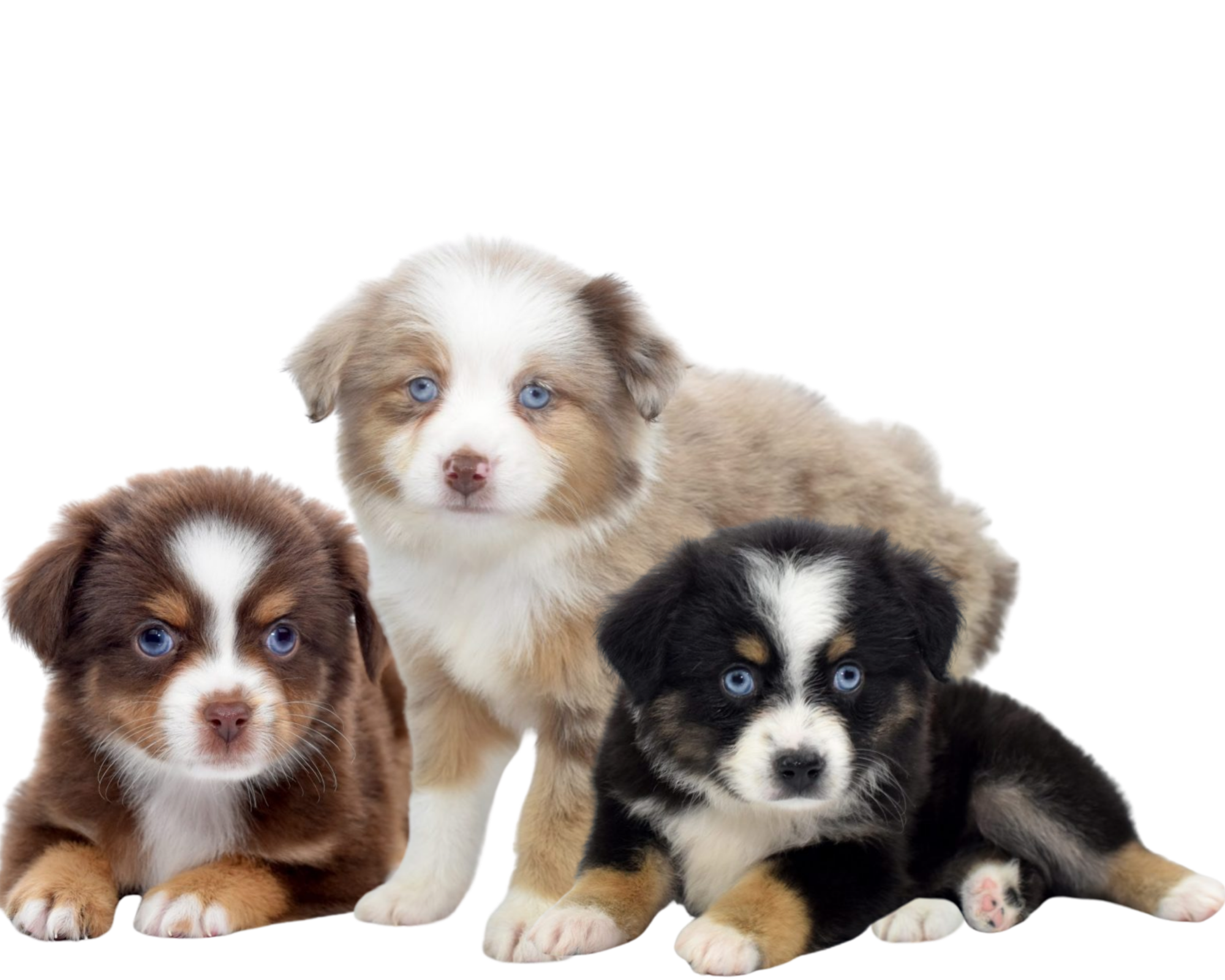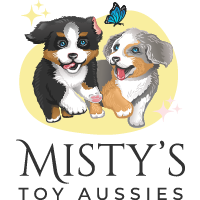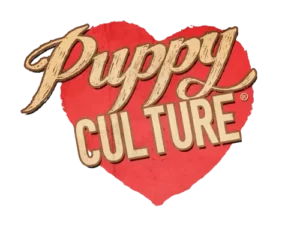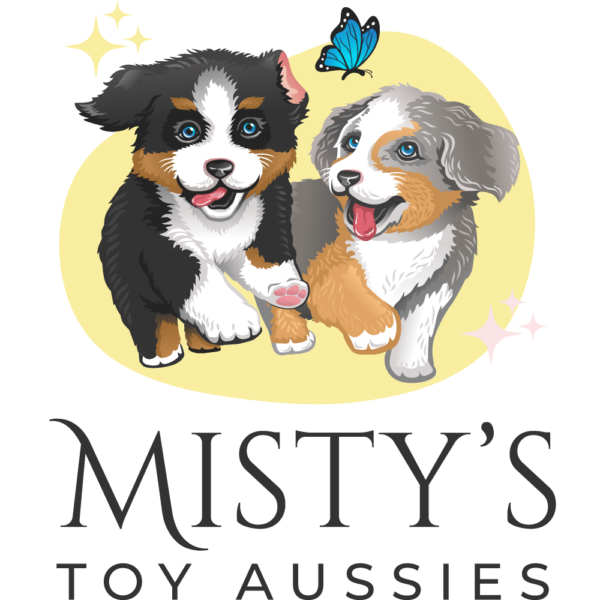Puppy
Curriculum
"When a dog is balanced, you are going to have a true friend."
- Cesar Milan

Jump Start Program
These days anyone can go online and find the picture-perfect puppy, or walk into a pet store and take one look and fall in love. Many breeders do not prepare their puppies for life the same ways we do, to the detriment of the puppy and its new family. While we also have a soft spot for all puppies, we believe it’s important to start young to shape and develop the puppies into superior companion pets.
We’ve spent years developing our program. We’ve studied scientific literature, watched thousands of hours of videos, consulted other breeders, trainers, and Veterinary Professionals. We found Jane Killion’s Puppy Culture Program and took parts of that, and incorporated what we found works best for us and the Toy Aussie breed specifically, and developed our own protocols. I guess you could say that we raise our puppies using a modified version of Puppy Culture to adapt to our breeds standards as we believe not all breeds are the same.
We have the puppies for the first 8 weeks of their lives and we start them with science-based positive reinforcement protocols, as early as 3 days old.
We begin with Early Neurological Stimulation (ENS), and Early Scent Introduction (ESI) exercises starting at Day 3 and continue daily through Day 16.
.
WHAT IS ENS?
ENS - Early Neurological Stimulation: A series of handling exercises proven to shape the brain's response to new stimuli. Designed by the US Military to improve trainability, brain function, and produce tolerant and relaxed pets.
WHAT IS ESI?
ESI - Early Scent Introduction: a training program for puppies designed to enhance their ability to identify, and react to, specific scents.
We offer each puppy a different scent each day. A scent that does not activate taste buds, but rather the nose. This builds nose awareness and confidence.
ENS BENEFITS
ENS/ESI are performed during days 3-16 of life. As they grow, we transition into puppy massages, where we get them used to being touched in mouths, paws, ears, toes, & nails.
ENS and ESI are just a very small part of what we begin with and do daily. Every week we work on something new. Anyone who places reservation on one of our future puppies will get access to our VIP area, which will have more details on what we are working on for the week with each litter.
Using these protocols, we can improve the lives of the puppies and limit behavioral issues by helping the puppies to cope with and move past things that would otherwise cause issues as adults.
Puppies raised using these methods are known to have less issues, more brain development, more bonding, more balance and the ability to adjust better.
Our goal is to raise socially well-adjusted puppies and give them the best possible start in life.
Continued Education
We have done our part, and now we leave it up to you to continue training and building your pup’s solid foundation. All of our puppies come with not only lifetime breeder support, but a lifetime membership to BAXTER & Bella’s Online Puppy School so please, we strongly encourage you to take advantage of all the tools we will provide you to have a happy and confident puppy that will grow into your very best friend.

building a foundation
Scientific Studies have shown that animals who are raised in a stimulus rich environment (such as ours), with lots of toys, exercise, and challenges, have larger brains, with more neuro-connections than animals raised in a stimulus poor environment. The stimulation actually causes animals to grow up to 5% more brain (and within that 5% more brain, are anywhere from 25 – 200 neuro-connections!) Studies have shown that the area of the brain where these new brain cells form is actually the area related to learning, memory, and emotional response. This is consistent with the findings of scientists that animals raised in enriching environments demonstrate increased learning ability, with better retention, and appear more stable, less fearful and better able to cope with and recover from frightening or stressful things. So, by going above and beyond with our puppies (and especially between the puppy’s 3rd and 16th days of life by providing early neurological stimulation), we can shape our puppies’ futures to be the best that they can be so that they can be the dog that everyone would want to own.
In addition, it is HIGHLY recommended that you get out with your new puppy and allow them to experience as many different things as they can.
This means getting your dog out and meeting new people (of all races, heights, genders, ages, with different objects such as hats, high heels, boots, coats, crutches, canes, etc.), meeting new dogs (of all shapes and sizes, long hair, short hair, floppy and prick ears, puppies, adults, disabled, etc.) and as many experiences as you can, especially if your puppy is going to be partaking in them when he or she is an adult (such as camping, boating, car rides, etc.) Be cautious, but get out there! 🙂
By continuing this for the rest of your puppy’s life, you will create a puppy that will be happy, carefree, and a joy to live with and allow the puppy the life he or she was destined to live. Both you and your puppy will enjoy your many journeys through life together, with very few, if any, behavioral problems.
one more thing ...
Because these are young puppies, these skills are taught without distractions present. As your puppy gets older, you will need to continue working on these skills in environments with increasing distractions.
It is also important to remember that you are getting a puppy – a baby dog – so that while we provide the best foundational training possible, you are still getting a puppy, and a puppy can never be fully trained and reliable as a mature, adult dog.
Puppies at this age cannot be expected to be fully house trained, or to not cry/bark/whine and should still be expected to engage in rowdy or potentially destructive behaviors when not supervised.


